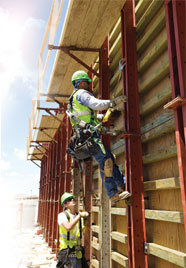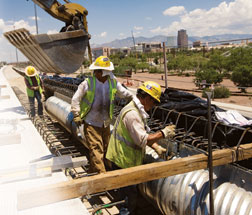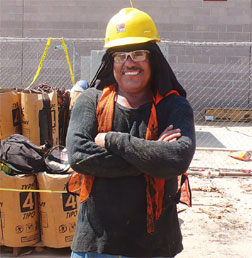 Michael Goodman /ENR Long sleeves keep moisture close to a worker’s skin.
|
Randy Mullins remembers all too well what it was like suffering heat exhaustion eight years ago. It was a windless day in Phoenix, and he’d just eaten lunch. “It just sneaks right up on you,” he recalls. “It hurts. I was cramped up. I [vomited] and passed out. It was the worst feeling I’d ever had.” He spent the night in a hospital with an IV.
Mullins, now a foreman with Kiewit Western Co., Phoenix, keeps a close eye on the crews working on a $200-million Interstate 10 widening project in Tucson. Temperatures there hit 107°F in the summer, but workers say it’s far more pleasant than the 117° average temperature in Phoenix.
Mullins scrutinizes the crews during toolbox safety meetings, looking for red eyes, signs of exhaustion or hangover. He also keeps an eye on new workers, identified by their green hardhats. During the shift, “I’ll make these guys stop for water breaks,” he says.
Common sense, acclimation and a strong heat-safety ethic were evident on five project sites that ENR recently visited in the Phoenix and Tucson area. “Experience counts,” says Arizona Dept. of Transportation spokesman Doug Nintzel. “ADOT personnel and contractors are used to the heat.”
|
Summer customs include switching paving to nighttime shifts once daytime temperatures reach 100°. “Some contractors will batch concrete with ice or chilled water to control the curing process,” Nintzel says. Retrofitting highways with 1-in. overlays of temperature-sensitive rubberized asphalt is usually avoided altogether during the hottest months.
Arizona average temperatures have increased by 2.2° between 2003-2007, compared to a global average of 1°, according to a report released in March by the National Resources Defense Council and the Rocky Mountain Climate Organization. In June, the Centers for Disease Control and Prevention reported during 1992-2006 there were 423 heat-related deaths of U.S. workers, with 148 in the construction industry. At .11 deaths per 100,000 workers, that is more than 5 times higher than the rate for all workers combined.
An analysis of Bureau of Labor Statistics num-bers, run by Silver Spring, Md.-based CPWR-Center for Construction Research and Training, found 16 construction workers died due to extreme heat out of 1,280 total deaths in 2006. There also were 730 cases of lost-time illness/injury as a result of “exposure to environmental heat.” Mary Watters, spokeswoman for the nonprofit organization, says milder cases of heat exhaustion are probably under-reported.
 Michael Goodman /ENR Gloves are a given when handling steel pipe in the heat of day.
|
Such cases aren’t necessarily only in desert regions. Washington State’s Dept. of Labor and Industries imposed an outdoor heat rule on July 5 after tallying five deaths and 582 compensation claims over a 10 year-period. Two of the fatalities were workers in construction.
The rule requires training so employers recognize symptoms of heat stroke, says Elaine Fischer, agency spokeswoman. She says in western Washington, where it rarely exceeds 85°, awareness is especially important. “How long a person has been on the job, what they’re wearing, and how used they are to higher temperatures are all important,” Fischer says.
The rule requires extra water be available based on temperature and clothing or type of gear the worker wears. For workers in average work clothing, the temperature threshold is 89°. Wearing fall protection gear or heavy work belts drops that to 77°. A written plan of how to handle heat stroke on each specific job is mandatory. Some 650 people have attended “train the trainer” workshops since June. Another l75 attended workshops held in Spanish.
Raising Arizona
At the site of construction of a new $89-million, 24-million-gallon-per-day water treatment plant in Gilbert, Ariz., “we start as early as 5 a.m. and end at 1:30 p.m.,” says Thomas Maher, senior project superintendent with Sundt Construction Inc., Tempe.
 Aileen Cho /ENR Workers sport “Lawrence of Arabia” look.
|
The plant will remove solids and disinfect drinking water with ozone. Like other treatment plants, the project includes pumps, concrete chambers, reservoirs, tanks and offices. Clint Sundt, Sundt project manager, says the hot weather affects various project elements. “We have stainless steel or PVC pipes. You can’t place those on a hot day,” he says. “You have to adjust the concrete admixes. Applications of coatings are affected. You have bubbling epoxy in the heat.” To accommodate, crews do as much mixing, placing and applying as possible at night.
But daytime work is inevitable. For instance, roofing cannot be done at night due to its inherent dangers. But roofers are most exposed to the sun while working on a hot surface radiating heat.
The goal is to balance between keeping pace with the schedule and not pushing workers beyond what’s safe, says Maher. “My focus is to work smart, not just fast,” he says. “Safety has got to be prioritized over productivity. It means nothing to meet the schedule if the safety record is not good.”
Although Southwestern construction workers are used to the heat, safety training is meant to prevent complacency. Frequent breaks in the shade or an air-conditioned vehicle are encouraged. “We communicate the dangers of heat exhaustion...
 Related Links:
Related Links: 
Post a comment to this article
Report Abusive Comment